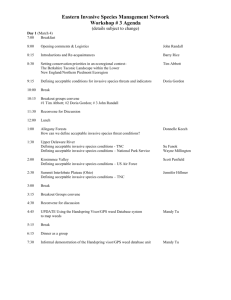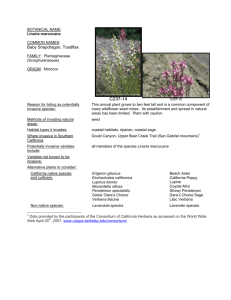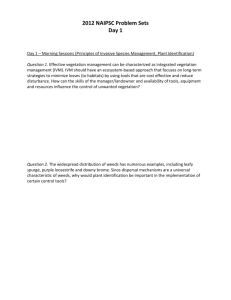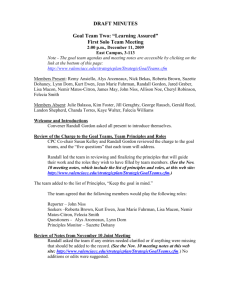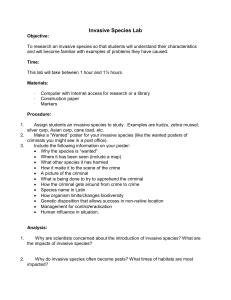Stas Burgiel, Senior Global Invasive Species Policy Advisor
advertisement
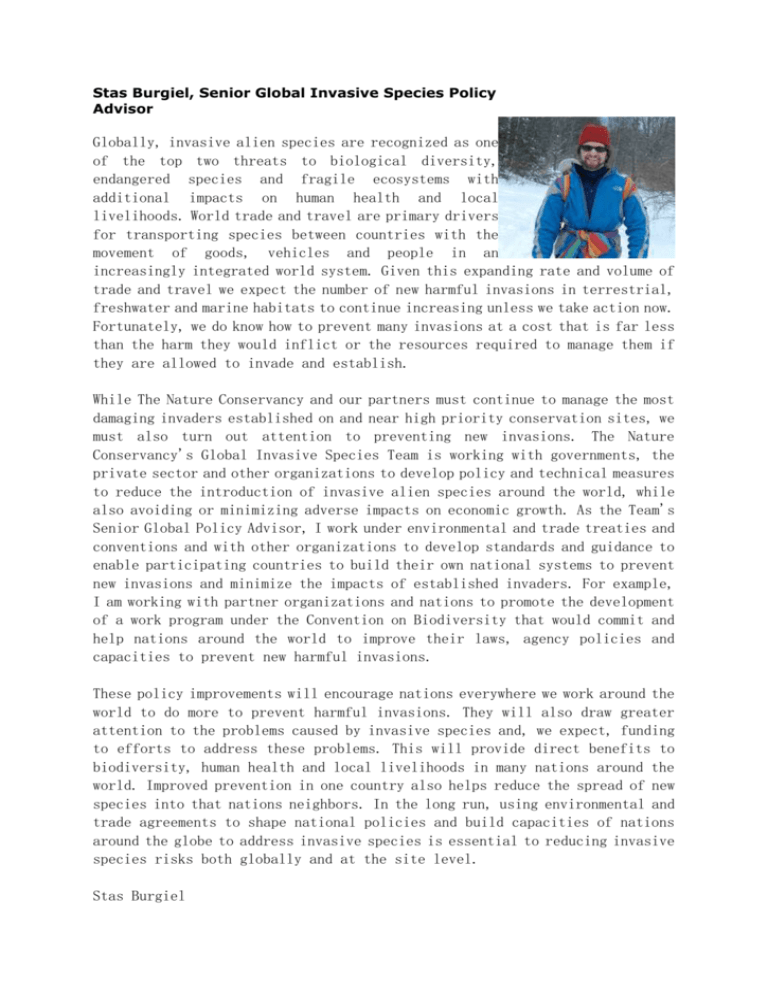
Stas Burgiel, Senior Global Invasive Species Policy Advisor Globally, invasive alien species are recognized as one of the top two threats to biological diversity, endangered species and fragile ecosystems with additional impacts on human health and local livelihoods. World trade and travel are primary drivers for transporting species between countries with the movement of goods, vehicles and people in an increasingly integrated world system. Given this expanding rate and volume of trade and travel we expect the number of new harmful invasions in terrestrial, freshwater and marine habitats to continue increasing unless we take action now. Fortunately, we do know how to prevent many invasions at a cost that is far less than the harm they would inflict or the resources required to manage them if they are allowed to invade and establish. While The Nature Conservancy and our partners must continue to manage the most damaging invaders established on and near high priority conservation sites, we must also turn out attention to preventing new invasions. The Nature Conservancy's Global Invasive Species Team is working with governments, the private sector and other organizations to develop policy and technical measures to reduce the introduction of invasive alien species around the world, while also avoiding or minimizing adverse impacts on economic growth. As the Team's Senior Global Policy Advisor, I work under environmental and trade treaties and conventions and with other organizations to develop standards and guidance to enable participating countries to build their own national systems to prevent new invasions and minimize the impacts of established invaders. For example, I am working with partner organizations and nations to promote the development of a work program under the Convention on Biodiversity that would commit and help nations around the world to improve their laws, agency policies and capacities to prevent new harmful invasions. These policy improvements will encourage nations everywhere we work around the world to do more to prevent harmful invasions. They will also draw greater attention to the problems caused by invasive species and, we expect, funding to efforts to address these problems. This will provide direct benefits to biodiversity, human health and local livelihoods in many nations around the world. Improved prevention in one country also helps reduce the spread of new species into that nations neighbors. In the long run, using environmental and trade agreements to shape national policies and build capacities of nations around the globe to address invasive species is essential to reducing invasive species risks both globally and at the site level. Stas Burgiel Global Invasive Species Team The Nature Conservancy 4245 North Fairfax Drive Arlington, VA 22203-1606 Stas Burgiel Burgiel 博士是全球入侵物种协会(GISP)外事工作组主任。全球入侵物种协会目前正联合 政府,私营单位以及其他组织一同制定政策及技术措施以降低全球范围内外来入侵物种的 引进,同时也在最大限度上减小这些措施对经济增长的损坏。Burgiel 博士作为该工作组的 高级全球政策顾问,主要研究环境贸易条约及公约,并且与其他组织一同制定相关标准及 指南,帮助成员国建立自己的国家机制抵御新的入侵行为并最大限度减小已建群入侵种所 带来的危害。Burgiel 博士与合作组织及国家正在推动一个在生物多样性公约的指导下的工 作项目的发展,该项目在世界范围内承诺并帮助成员国改进他们现有的法律,机关制度以 及增强抵御新的有害物种的能力。 John M. Randall Wildland Invasive Species Team Director Contact Information The Nature Conservancy Wildland Invasive Species Team 124 Robbins Hall Department of Vegetable Crops & Weed Science University of California Davis, CA 95616 Phone: (530) 754-8890 Fax: (530) 752-4604 E-mail: jarandall@ucdavis.edu Brief Biography John is Director of The Nature Conservancy's (TNC) Wildland Invasive Species Team. He is based in and has an unpaid appointment with the Department of Vegetable Crops & Weed Science at the University of California, Davis. John heads a small team that provides leadership, scientific support, information and advice on issues regarding invasive species, their prevention, and their control on Nature Conservancy sites and selected conservation areas across the U.S. and the other 23+ nations where TNC works. He also helps develop public policy approaches designed to prevent new invasions and minimize the spread and environmental damage cause by already established species with public agencies and private industries. John helped found the non-profit California Exotic Pest Plant Council (CalEPPC) and served as its first president in 1993 and '94 and served on the Board through 2000. John is on the Board of the Center for Invasive Plant Management based in Missoula, MT. and is also a member of the IUCN (World Conservation Union) Invasive Species Specialist Group and the steering committee for the U.S. Forest Service's Forest Health Technology Enterprise Team. He co-edited the books Invasive Plants of California's Wildlands (2000) and Invasive Plants: Weeds of the Global Garden (1996). John completed a Ph.D. in Ecology at the University of California, Davis in 1991. His research project focused on the biology and control of the non-native invader, bull thistle (Cirsium vulgare) in Yosemite Valley. He received an MS in Marine Science from Louisiana State University in 1986 and a BA from Cornell in 1982. Selected Publications Chornesky, E.A. and J.M. Randall. 2003. The threat of invasive alien species to biological diversity: setting a future course. Annals of the Missouri Botanical Garden 90: 67-76. Byers, J.E., S.H. Reichard, J. M. Randall, I.M. Parker, C.S. Smith, W.M. Lonsdale, I.A.E. Atkinson, T. R. Seastedt, M. Williamson, E. Chornesky and D. Hayes. 2002. Directing research to reduce the impacts of nonindigenous species. Conservation Biology 16(3):630-640. Barthell, J.F., J.M. Randall , R.W. Thorp and A.M. Wenner. 2001. Promotion of seed set in yellow star-thistle by honeybees: evidence of an invasive mutualism. Ecological Applications 11(6): 1870-1883. Randall, J.M., N. Benton and L.E. Morse. 2001. Categorizing invasive plants: the challenge of rating the weeds already in California. pp. 203-216 In R.H. Groves, F.D. Panetta and J.G. Virtue (eds.) Weed Risk Assessment. CSIRO Publishing: Collingwood, Victoria, Australia Barthell, J.F., R.W. Thorp, A.M. Wenner and J.M. Randall. 1999. Yellow star-thistle, gumplant, and feral honeybees on Santa Cruz Island: a case of invaders assisting invaders. Pp 269-273. In Proceedings of the 5th California Islands Symposium, Santa Barbara, CA. Randall, J.M., M. Rejmánek and J.C. Hunter. 1998. exotic flora of California. Fremontia 26(4):3-12. Characteristics of the Randall, J.M. 1997. Defining weeds of natural areas. pp. 18-25 Luken and J. Theiret (eds.) Assessment and management of plant invasions. Springer, New York. In J. Randall, J.M., R.R. Lewis III and D.B. Jensen. 1997. Ecological restoration and non-indigenous species invasions in Florida. 205-219 In D. Simberloff, D. C. Schmitz and T. C. Brown (eds.) Strangers in paradise: impact and management of non-indigenous species in Florida. Island Press, Washington, D.C. Randall, J.M. biodiversity. 1996. Weed control for the preservation of Weed Technology 10 :370-383. Rejmánek, M. and J.M. Randall. 1994. Invasive Plants in California: 1993 summary and comparison with other areas in North America. Madrono 41:161-177. Rejmánek, M., P.S. Ward, GL. Webster and J.M. Randall. 1994. Systematics and biodiversity. Trends in Ecology and Evolution (TREE) 9:228-229 Forcella, F. and J.M. Randall. 1994. Bull thistle, Cirsium vulgare (Savi) Tenore. Reviews of Weed Science 6:29-50. Randall, J.M. and M. Rejmánek. 1993. Interference of bull thistle (Cirsium vulgare) with growth of ponderosa pine (Pinus ponderosa) seedlings in a forest plantation. Canadian Journal of Forest Research 23: 1507-1513. Randall, J.M. 1991. Population dynamics and control of bull thistle, Cirsium vulgare, in Yosemite Valley. pp. 261-281 In R.F. Doren, R.L. Hofstetter, R.L. Meyers and L.D. Whiteaker (eds.) Proceedings of the Symposium on Exotic Pest Plants. University of Miami, Florida, 1988. United States Department of Interior / National Park Service. Randall, J.M. & J.W. Day, JR. 1987. Effects of river discharge and vertical circulation on aquatic primary production in a turbid Louisiana (USA) estuary. Netherlands Journal of Sea Research 21: 231-242. Randall, J.M. and J. Marinelli (eds.) 1996. Invasive plants: weeds of the global garden. Brooklyn Botanic Garden, New York. 2001. Weed Control Methods Handbook: Tools and Techniques for Use in Natural Areas. 195 pages. http://tncweeds.ucdavis.edu/handbook.html Tu, I.M., C.C. Hurd and J.M. Randall. Bossard, CC., J.M. Randall and M. Hoshovsky. (eds.) 2000. Invasive Plants of California's Wildlands. University of California Press, Berkeley, CA. John M. Randall Randall 博士是大自然保护协会(TNC)入侵物种小组主席,是加尼福尼亚大学戴维斯校区 的兼职教授。他所率领的小组为全美及隶属于 TNC 的其他 23 个国家的自然保护区及重点 保护区域提供指导人员,科学支持,以及入侵物种的防治等。Randall 博士还是世界自然 保护联盟入侵物种专家组的成员。他与同事共同编写了两本书――Invasive Plants of California's Wildlands (2000) and Invasive Plants: Weeds of the Global Garden (1996)。 Randall 博士同样也有大量文章发表于 Trends in Ecology and Evolution 等杂志。
